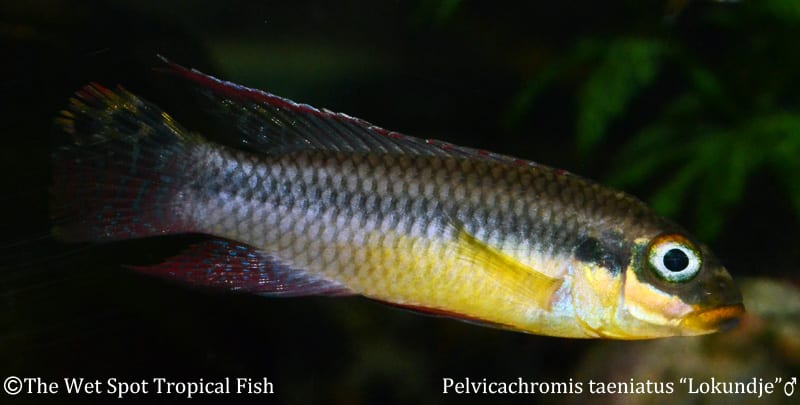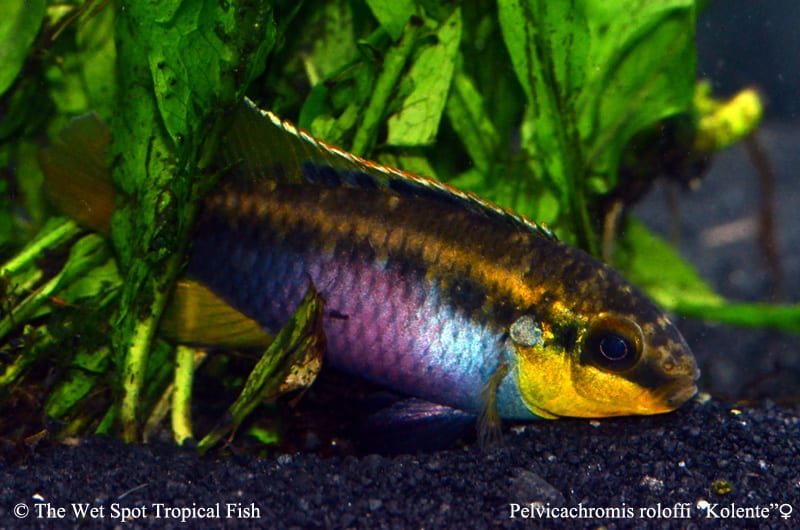Work Hard, Play Hard!
Work Hard, Play Hard!
| As the work week and the month of August simultaneously roll to a close, the bitterness of ending summer is sweetened with a well-deserved long weekend. Here at the Wet Spot, we know what it’s like to work hard, and too want to use our free time to de-stress with our favorite hobbies. Satisfying as being a professional-level aquarist can be, most of us don’t consider caring for high-maintenance fish in large tanks the ideal way to kick back in our brief and precious respites between work weeks. That, however, doesn’t mean hobbyist tanks have to be boring! Beknownst to many, there are several peaceful, colorful, hardy, and behaviorally complex species of “dwarf cichlids” from Africa, great for smaller community tanks. This labor day, we’ll take a closer look at a few of our favorites: Pelvicachromis drachenfelsi “Taeniatus Wouri”, Pelvicachromis kribensis “Taeniatus Lokoundje”, and Pelvicachromis roloffi “Kolente”. |
|
| These pair-bonding cave-spawners are often known as “Kribensis” or “Kribs”, and are found in soft, acidic rivers in West and Central Africa. In captivity they do best in biotope tanks with sandy substrate, branches, water-worn rocks, and dense vegetation (think: Anubias and Bolbitis to keep it simple). Additionally, they should be provided ample hiding places, like caves, upturned clay pots, PVC pipes, and nooks and crannies formed from natural furnishings. Dwarf cichlids can tend toward shyness, but this is tamped down when they have refuges to retreat to, and they will even breed readily in their privacy nooks. Males and females are easily differentiated, where males tend to be slightly larger-bodied with pointed dorsal and anal fins, diamond-shaped caudal fins, and will exhibit colorful throats during breeding. Females are smaller, with rounded fins, and are more brightly colored with rounded, brightly-colored bellies. Peaceful by nature, they can be kept in most community setups, but congeners in their natural environments include Buffei catfish, tetras, and killifish. They are not suitable additions to other cichlid tanks, who almost always pick fights with their docile cousins. Mostly herbivorous in the wild, they feed predominantly on algae and soft plants. In aquaria they should be fed high-quality veggie flake with fresh greenery regularly interspersed in their diets. Tank waters should generally be kept with temperatures between 72 and 79°F, pH of 5.0 to 7.0, and hardness around 90 to 215 ppm. |
|
See Current Availability
Native to the Wouri river system of southwestern Cameroon, P. drachenfelsi stays under 2.5 inches in length. Known more commonly as Taeniatus Wouri, they are golden in color with the characteristic pink bellies highlighted with shiny turquoise scales, copper fins with a black ridge on the dorsal fin, and a small black spot on the caudal fin.
See Current Availability

Found in coastal waters of Cameroon, P. kribensis “Lokoundje” is a lovely dwarf cichlid maxing out around 2.6 inches in length. They are cobalt blue with light pink undertones and bright yellow faces and fins.

See Current Availability
A rare gem in eastern Guinea, Sierra Leone, and western Liberia, P. roloffi is hard to obtain in the aquarium trade. Reaching around 3 inches, males are larger, and exhibit silver bodies with a dark lateral stripe, a red-scaled cheek spot, and red, blue, yellow, and black patterning on their fins. Females are the more colorful sex with their vibrant purple bellies, and bright yellow faces and fins.
Nothing kills a hobby more than hard work…or boredom…sounds like most desk jobs, right? Well, aquarists are lucky, and can have the best of both worlds- simple care and interesting observations, all courtesy of these lovely African dwarf cichlids! Happy Labor Day aquarists!


